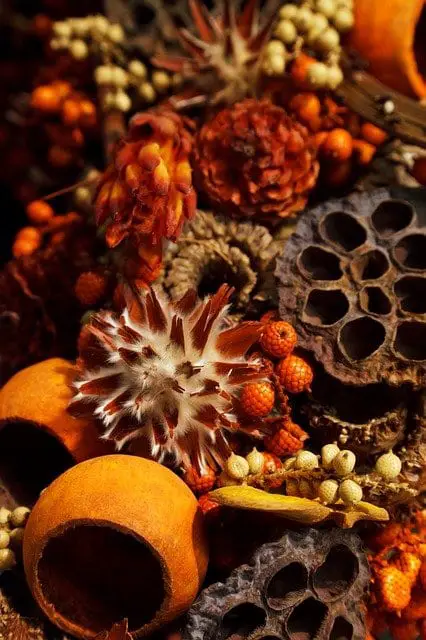
Image source – Pixabay
The word potpourri has an extremely amusing and likely surprising origin. It is an English word which is derived from the French “pot-pourri” which literally translates to putrid pot. The word is now more commonly accepted as describing a collection of dried flower petals, leaves, herbs, and spices used to scent the air. The history of potpourri dates back to the 12th century, where its use in freshening up dank and musty medieval castles was most appreciated. The first documented use of the term “potpourri” was in 1749. Potpourri has a recorded history of over 6000 years as lack of plumbing and acceptable bathing practices made the need of scents and perfumes more urgent. Buildings and homes lacked ventilation and fragrant dried flowers, herbs and spices were strewn on floors to combat the worst of the odors.
In modern times, these perfumed bundles of dried flowers, herbs and spices occupy a wider role. Some herbs and flowers such as lavender and chamomile are considered particularly useful for their sleeping aid properties. Others help to freshen up lingerie and woolen clothes kept in closets from the musty smell of protective moth balls. Potpourri also acts as a festive and decorative accent during Christmas and other joyous occasions.
Facts about Potpourri
- It is pronounced poh‐pooh‐ree and means “rotten pot” in French
- The earliest use of potpourri in English was to describe a type of stew.
- The word appeared in its earliest form in Randle Cotgrave’s 1611 French-English dictionary in which he defined it as “a Spanish dish of many severall meates boyled, or stued together.”
- It was only in the middle of the 18th century that it attained its modern meaning to describe a fragrant mix of dried flowers.
- The word is also used to refer to the vessel which was used to create potpourri. A decorative ceramic vessel with a perforated cover was originally used to hold a wet blend of spices, flowers and herbs. This blend would over time emit a fragrance through the vessel’s vents, thus perfuming the surroundings
- In modern times, the term potpourri is frequently used to refer to an unusual or interesting mixture of things, a miscellaneous medley of objects etc.
- Potpourri was considered extremely valuable in the days before plumbing and even worn on the body. It was sewn into small cloth sacks which were known as sachets or sweet bags.
- In addition to its obvious use in disguising rotten odors, the blend of herbs, flowers and spices was also believed to ward off disease.
- Nineteenth century experiments at the Pasteur Institute in Paris showed that bacteria of certain diseases prevalent during the Middle Ages appeared to be destroyed by some fragrant herbs’ oils.
- The word also found a place in literature. In the novel Orlando, written by Virginia Woolf, the central character buries her face in a bowl of family potpourri.
- In 1977, in the US, Henri Bendel became the first high-fashion store to bring potpourri into its own boutique. The scent of choice was a woodsy blend from San Francisco called Agraria. Bowls of Agraria, studded with orange rinds and cinnamon sticks, turned up in department stores and living rooms of the rich and famous in Park Avenue.
- Early in the 1980s, potpourri became a part of the mainstream.
- By 2011, sales of potpourri had declined and the product became much less fashionable. Sales of scented candles and reed diffusers went up 5% to £41m, while pot-pourri dropped by 14%.
- In 2019, potpourri seemed to be experiencing a resurgence in the luxury markets.

Image Source: Pixabay
Potpourri over the ages
Prehistoric
Some form of potpourri is speculated to have been in use as early as the times of cave dwellers. While floral bouquets have been found in the graves of prehistoric people, the exact use of dried herbs and flowers is merely hypothesized. It would be understandable, given their austere and primitive lives with the accompanying odors that the prehistoric man would take advantage of flowers and herbs’ fragrant properties.
Ancient Egypt
Lavender, thyme and chamomile were used during the Egyptian mummification process. Evidence of their use can be found in the remains of ancient tombs.
Middle Ages
In the Middle Ages in Europe, potpourri was frequently used to freshen bed linen and clothing closets. The lack of bathing and laundering created a bigger need for substances that would mask the lingering smell. Even amongst the peasant class, it was common to hang bouquets of dried herbs outside dwellings to ward off insects and for their pleasing aroma.
15th-16th century, England
Bundles of dried herbs were burned indoors to fumigate rooms against the plague.
17th century, France
Potpourri became extremely popular in 17th century France. Flowers that abundantly bloomed during the spring and summer were collected in ceramic vessel and mixed with salt. The salt acted as a drying agent. This combination was then layered in autumn with seasonal spices like orange peel and cinnamon stick.
Victorian England
In the Victorian times, dried flowers and herbs were combined with various fixatives like essential oils and orris root. The resulting potpourri was used primarily as a decoration. Since oils were more readily available in apothecaries, the process of making potpourri also became more refined and easy during this time. Victorian ladies were also known to carry small bundles of flowers and herbs as they travelled through foul smelling streets. Women also hid sachets of flowers and herbs within their petticoats.
Common Ingredients
There are a variety of ingredients commonly found in a potpourri recipe. Roses are the most popular flowers used in preparing potpourri as they retain their scent even after drying. Some other botanicals used in a traditional potpourri preparation include:
- All spice
- Cedar wood shavings (also acts as a moth repellent)
- Cinnamon bark and cassia bark
- Cloves
- Cypress wood shavings
- Fennel seeds
- Jasmine Flowers and Oil
- Lavender Leaves and Flowers
- Lemon Peel
- Orange Peel
- Rose Flowers or oil
Methods of preparing Potpourri
There are two traditional methods of making potpourri-the dry method and the moist method. The moist method is the oldest and produces more fragrant potpourri. However, the methodology doesn’t lend itself to visual appeal. Therefore, many modern crafters prefer the dry method.
The moist method involves using partially dried herbs and flowers and packing them within alternate layers of salt. They are then transferred to ceramic pots and left to cure for weeks or months. The dry method includes herbs, spices, leaves, barks and flowers. Dried citrus peel may also be added for color and scent. Some form of fixative and essential oil is then combined with this chip dry mixture.
